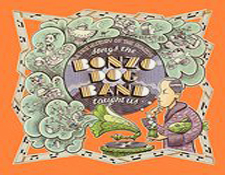It’s the time of year for saving money!
One of the really fun finds on Record Store Day is a two LP set that I nearly missed. Fortunately, my music buddy Frank clued me in on it and we got the two copies Amoeba Records had out in the racks that day. This set, called Songs The Bonzo Dog Band Taught Us is a sort of ironic title because its really about the songs that The Bonzo Dog Doo Dah Band learned and performed as part of their influential and beloved British counter-culture act in the mid-1960s, both on record, stage and television.
 But then again, if you buy this set (and the Bonzo’s albums) you’ll realize that they are in a way teaching you about this music’s history…. so perhaps the title is perfect…
But then again, if you buy this set (and the Bonzo’s albums) you’ll realize that they are in a way teaching you about this music’s history…. so perhaps the title is perfect…
Reading the wonderful liner notes in this fabulous set, we learn that the music here comes from the period in history between World Wars, roughly 1920 to 1939. Its focus is on the “novelty foxtrot” a dance music back in the day; for some of us here in the US, this music will sound like some of the jaunty-jolly music used in cartoons from studios like Warner Brothers and MGM in the 1940s and 50s.
Now, I suspect some of you may be asking: well, just who are The Bonzo Dog Doo Dah Band? Also known as simply The Bonzo Dog Band, they were a group of hip young British art school types who rediscovered and reinvented this fun and sometimes irreverent music for their new audiences in the swingin’ 60s, combining psychedelic rock and pop elements with surrealist humor, vaudeville and early “trad jazz” sounds. They peppered their original act with these sorts of tasty musical tibits from an earlier era.
 The Bonzos were no doubt better known in England than here in America, but their influence was certainly felt around the world (and continues to be felt). The Bonzos crossed paths with no less thanThe Beatles — who were big fans, giving them have a cameo in their 1967 made-for-TV movie Magical Mystery Tour, performing “Death Cab For Cutie” (and yes, that is where that modern day rock band got their name). Eventually Bonzo Neil Innes joined what became Monty Python’s Flying Circus (and later The Rutles!). Drummer Legs Larry Smith (who wrote some of the liner notes) had a cameo on Elton John’s Honky Chateau album performing a tap dance solo on one of the songs (among other appearances) while Viv Stanshell was the announcer introducing all the instruments at the end of side one on Mike Oldfield’s landmark progressive rock smash hit debut Tubular Bells.
The Bonzos were no doubt better known in England than here in America, but their influence was certainly felt around the world (and continues to be felt). The Bonzos crossed paths with no less thanThe Beatles — who were big fans, giving them have a cameo in their 1967 made-for-TV movie Magical Mystery Tour, performing “Death Cab For Cutie” (and yes, that is where that modern day rock band got their name). Eventually Bonzo Neil Innes joined what became Monty Python’s Flying Circus (and later The Rutles!). Drummer Legs Larry Smith (who wrote some of the liner notes) had a cameo on Elton John’s Honky Chateau album performing a tap dance solo on one of the songs (among other appearances) while Viv Stanshell was the announcer introducing all the instruments at the end of side one on Mike Oldfield’s landmark progressive rock smash hit debut Tubular Bells.
Now you might well write this compilation off as wacky a mad British thing, but there was some retro fascination going on here in America in the 60s, with some artists looking back to happier times amidst a period when the world was going to hell in a hand basket in the future. Consider the singing American music encyclopedia that was Tiny Tim (one of Bob Dylan’s first friends when he got to NYC, btw!) who hit it big in 1968 with his remake of Nick Lucas 1929 novelty “Tip-toe Through the Tulips with Me.” In 1967, a British group called The New Vaudeville Band hit #1 with their 20s-sounding song “Winchester Cathedral” (which according to the wiki only made it to #4 in the UK, only being bounced from the top spot in the US, after one full week, by The Beach Boys’ “Good Vibrations”). In 1972, former Beatles engineer and classic-era Pretty Things producer Norman “Hurricane” Smith had an international #1 hit with his 1920s-flavored smash “Oh Babe, What Would You Say?”
So it wasn’t all Hendrix ‘n Zeppelin, Zappa, Ziggy & T-rex back in those times, kids….
Retro was a thing, if you will… a fluffier melodic counter the increasingly electric sounds taking over the airwaves, especially after the insane murders of President John F. Kennedy and his brother, Senator Robert Kennedy as well as Reverend Martin Luther King.
 This sort of perspective makes mid-60s Summer of Love pop hits like The Fifth Dimension’s “Up Up & Away” and The Beatles’ “Penny Lane” all the more poignant — they were an audio escape to another, better, more innocent place and time.
This sort of perspective makes mid-60s Summer of Love pop hits like The Fifth Dimension’s “Up Up & Away” and The Beatles’ “Penny Lane” all the more poignant — they were an audio escape to another, better, more innocent place and time.
Let me take you down … to … Strawberry Fields…
Anyhow… back to the Bonzos and this review at hand.
So…someone had the bright idea to put together this collection that compiles 27 original songs from the 1920s and 30s on to two lovely 180-gram, very quiet, butterscotch colored vinyl LPs — note that color is no accident as it is roughly the look of some early shellac 78 RPM discs from that period! Some of these are very obscure records which were made for budget labels while others were out on major labels, so the sound quality varies. This is especially true when comparing records made acoustically vs. the later recordings which were done electrically with microphones.
But overall this album is a very enjoyable and fascinating listen of high camp gems.
Some of my favorites include “Ali Baba’s Camel” by The Rhythmic Troubadours with its eyebrow-raising lyric “Out for what we all want, lots of L.S.D.” Yikes! L.S.D. in 1931? Well, as an English Facebook friend alerted me, L.S.D. was a term for (according to the Wiki) “pre-decimel currencies once common through out Europe” (with the “L” being the symbol for the British pound, £ , originating from Latin denominations librae, solidi, and denarii). So, yah, they wanted lots of money in the 1920s, not Owsley’s trips.
]]>But still, you can imagine what an in-joke this song must have been for those “experienced” fans of The Bonzo Dog Band back in the day.
 Wink wink, nudge nudge, if you know what I mean… (and yes, that is a Monty Python reference you just read).
Wink wink, nudge nudge, if you know what I mean… (and yes, that is a Monty Python reference you just read).
Say no more… say no more…
Twitterers may get a kick out of “I Lift Up My Finger And I Say ‘Tweet Tweet'” by Jay Whidden & His Band.
You’ll also hear tunes by some potentially familiar names here such as Jelly Roll Morton, Guy Lombardo and Noel Coward. But songs like “Masculine Women! Feminine Men!” from 1926 presage the gender challenging movement that started to raise its proud Peacock feathers in the late 60s. As you listen to these tracks, consider the long haired fey ‘n sloppy fop character that was Tiny Tim (who, by the way, covered Biff Rose’s “Fill Your Heart” three years before Bowie) to the aggressively androgynous Ziggy Stardust emerging just a few years later.
 So, yeah, people wanted some escape and the Bonzo’s offered it to their fans in buckets!
So, yeah, people wanted some escape and the Bonzo’s offered it to their fans in buckets!
Songs The Bonzo Dog Band Taught Us explores the high camp and wacky, from “I Love To Bumpity Bump” to “Bell Bottom Trousers.” There are even nice reprints pictures of sheet music art work of some of the songs in the laminated gatefold sleeve.
Supposedly a limited edition release, if you can’t find the album on LP fear not as Songs The Bonzos Taught Us is available on CD. If you are not familiar with the Bonzo’s music, I might also suggest you check out the handy album The History Of The Bonzos (which this album cover loosely mirrors, with its old tyme 1920s looking artwork).
Songs The Bonzo Dog Band Taught Us is at its root a fun game of connect the musical dots!






